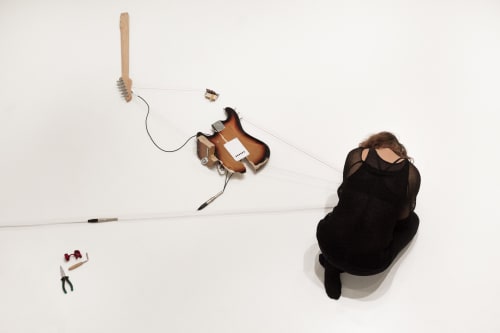The Bass Museum of Art
2100 Collins Ave. Miami Beach, FL 33139
Open Wed–Sun 12–5pm
+1 (305) 673-7530
Live Performance Schedule
Tuesday, November 30 |
2 pm and 4 pm |
Wednesday, December 1 |
2 pm and 4 pm |
Thursday, December 2 |
2 pm and 4 pm |
Performances are included in the price of admission; space is limited and available on a first-come, first-served basis. Performance duration is approximately 35 – 45 minutes.
ON VIEW NOVEMBER 28, 2021 - May 29, 2022
Book tickets and plan your visit HERE »
Opening Sunday 28 November 2021, The Bass presents Perimeters, a solo exhibition of new and site-specific work by Israeli born, New York-based artist Naama Tsabar. Offering the potential for activation and performance throughout, the exhibition centers on Tsabar’s most recent series, Inversions, presenting new iterations of four bodies of work that Tsabar has explored from 2006 to the present.
Naama Tsabar works at the intersection of architecture and music, showing viewers how sound moves both through and beyond walls and buildings. She often makes large-scale collaborative performances, sculptures and installations that can be played by musicians and visitors alike. For Perimeters, Tsabar will fuse elements from sculpture, music, performance and architecture and transforms the museum itself into a playable instrument Tsabar’s interactive works expose hidden spaces and systems, reconceive normative gendered narratives and shift the viewing experience from passive observation to one of active participation. Using sound holes, instrument parts and microphones, Tsabar draws attention to the muted and unseen, propagating sound through space and sculptural form. Exploring the relationships between sculpture and instrument, as well as form and sound, Tsabar’s work lingers on the intimate, sensual and corporeal potentials within these transitional states. By collaborating with local communities of female-identifying and gender non-conforming performers, Tsabar contributes to feminist and queer discourses through movement, sound and space.
The exhibition begins with artwork created through destruction. Citing iconic moments in rock performance history, as well as Auto-Destructive art, Tsabar’s Melody of Certain Damage works are made by smashing guitars in her studio, documenting where the pieces fall and meticulously creating new string configurations for the fragmented instruments. Transforming the destroyed object into a newly playable instrument, Tsabar co-opts an action that embodies the male-dominated legacy of rock and roll: the breaking of a guitar first popularized by The Who’s lead guitarist Pete Townshend. However, by dislocating the violence of the destructive act and only showing viewers the scattered fragments, Tsabar presents the remains in a reimagined form that emphasizes reconstruction and repair after trauma.
A new work by Tsabar similarly gives sculptural form to acts and movement performed by the artist. The work, October 13 2019 – July 5 2021 (2021), is comprised of a pair of shoes fused with a working metronome. The shoes were worn by the artist during the fixed period of time encompassed in the title. Together, the metronome’s steady tempo and the shoes’ visible wear embody what the artist describes as, “a diary of time and body movement.” The even beat of the metronome recalls a clock, memorializing a record of the artist’s movements during a specific time as a type of portrait.
Another installation is Twilight (Gaffer Wall), a wall specific installation first exhibited by Tsabar in 2006, and then again in 2017. The work is a curved wall covered in strips of gaffer tape, the same tape used to mask and stabilize cables on stages and productions around the world. The utilitarian material, often associated with unseen backstage labor, moves from its functionally hidden location on the floor to a wall, where it becomes the focus as a sort of nocturnal night veil and transitional space.
Tsabar’s Inversions series uses the intermediate spaces within and between walls and architecture to reference sound holes and the craftsmanship of instrument building. Acoustic studies have proven that the sonic power of an instrument resonates strongest at the perimeters of its opening, known as a sound hole. This sonic phenomenon led to the design evolution of musical instruments, like the violin and guitar, while also leading to the exhibition’s title and Tsabar’s continued experimentation with sound-making structures. Embedded into walls, each work opens a space behind the wall that can be activated by both museum-goers and performers.
Depending on the work, activation comes through strumming hidden string elements, singing or the penetration and movement behind the walls to produce a sonic outcome. Tsabar’s most recent Inversions’ installations are activated by motion, rather than touch. The sonic vocabulary emanating from these structures are derived from female vocalists, asserting the power and beauty of the female voice within the exhibition space.
The exhibition uses the pervasiveness of sound and the acoustic effect of perimeters to suggest strength at the periphery rather than at the center, a politically-charged and timely concept. Perimeters encompasses works that embody polarities: destruction/creation; absence/void, presence/occupation and singularity/collectivity. Tsabar’s sensuous works require a certain intimacy, where visitors and performers must reach into the wall or crouch on the floor to interact with the sculptural and sonic forms, at once creating a personal experience, while also becoming part of a collective and symphonic experience as additional viewers activate the other works in the installation.
Tsabar’s works probe the power structures inherent to museums, symbolically breaking through institutional barriers for participation by both artists and visitors by inviting women and gender non-conforming performers and visitors to permeate and penetrate the museum’s architectural structures. Together, these gestures subvert and breakdown historical efforts to control behaviors and prioritize certain populations while excluding others, all of which have been tenets of museums since their inception.
